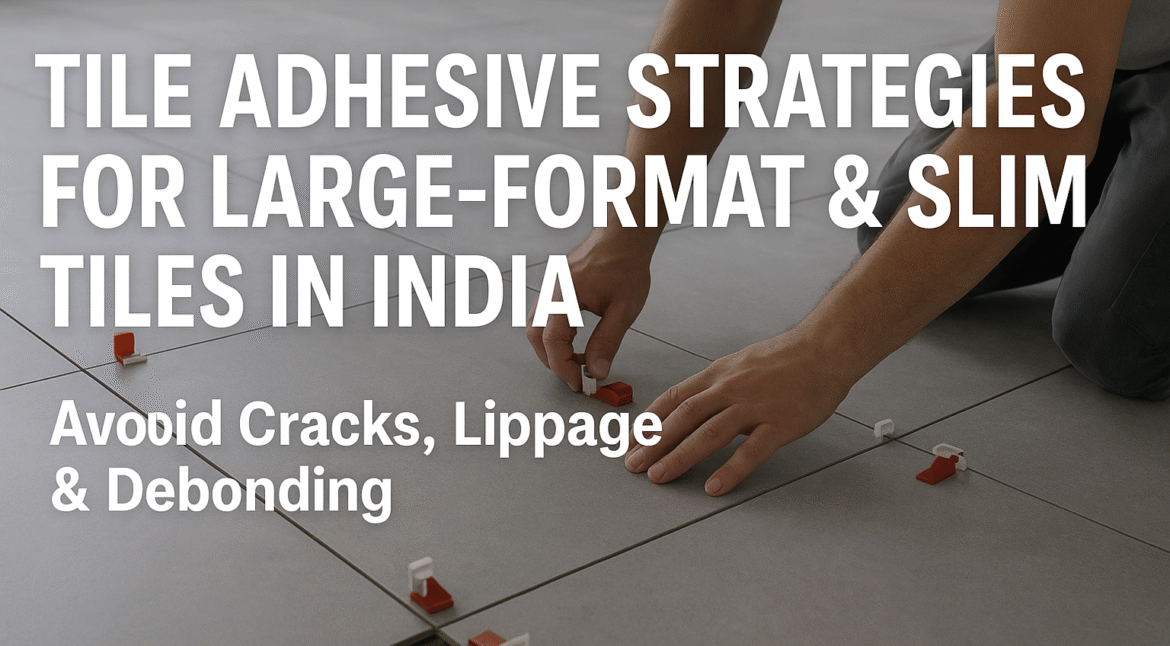Tile Adhesive Strategies for Large-Format & Slim Tiles in India: Avoid Cracks, Lippage & Debonding
In the modern Indian construction landscape, large-format and slim tiles are redefining architectural aesthetics. From luxury residences to high-end commercial spaces, these tiles offer seamless finishes, fewer grout lines, and contemporary appeal.
However, installing these advanced tiles is far from simple. Their size and density demand precision — and above all — the right tile adhesive. Using an unsuitable adhesive can lead to cracks, lippage (uneven surfaces), and even debonding, compromising the durability and beauty of the installation.
Common Questions Asked:
Q1. Can regular tile adhesive be used for large-format or slim tiles?
No, standard adhesives often lack the flexibility and bonding strength required for these tiles. Specialized, high-performance tile adhesives are essential to ensure uniform contact and long-term stability.
Understanding Large-Format and Slim Tiles
Large-format tiles, typically exceeding 600mm x 600mm, and slim tiles, with thickness as low as 3–6mm, are made from dense, low-porosity materials such as porcelain or vitrified ceramics.
Their minimal thickness and heavy weight make them prone to installation challenges if not bonded correctly. Traditional cement-sand mortar cannot provide adequate adhesion or compensate for surface movements — leading to voids, unevenness, and premature tile failure.
The solution lies in advanced floor and wall tile adhesives engineered to match these specific tile behaviors.
Why Specialized Tile Adhesives Are Crucial
1. Reduced Porosity Demands Higher Adhesion
Slim and large-format tiles have low absorption rates. This means regular mortars or basic adhesives cannot “grip” the back of the tile effectively. A polymer-modified adhesive with enhanced bonding strength, such as TERATILE PLATINUM, ensures full contact and long-lasting adhesion between the tile and substrate.
2. Preventing Air Voids and Debonding
With larger surface areas, the chance of trapped air beneath the tile increases. These voids can cause debonding or cracking under load. To counter this, installers must use adhesives with a buttering-and-floating technique for full coverage. Products like TERATILE PROLIX EXTRA provide excellent spreadability, ensuring even coverage across large tiles.
3. Managing Vertical Slip and Lippage
When applying slim tiles on walls, maintaining level alignment is challenging. High-performance wall tile adhesives with anti-slip properties are essential. For such cases, TERATILE DIAMOND offers excellent non-sag performance and high initial grab strength, preventing slippage during installation.
4. Flexibility to Withstand Structural Movement
Buildings naturally expand and contract due to temperature and load variations. A rigid adhesive can crack under such stress. Flexible, deformable adhesives with polymer modification maintain a strong bond even with minor substrate movements — a critical factor for large-format tiles.
Ideal Adhesive Characteristics for Large-Format & Slim Tiles
Selecting the best tile adhesive involves considering both material and environment. Here’s what professionals look for:
- High Polymer Content: Enhances bonding on low-porosity tiles.
- Extended Open Time: Allows better workability for positioning large tiles.
- Non-Slip Properties: Prevent tile movement on vertical applications.
- Flexibility & Shear Strength: Absorbs vibration and structural shifts.
- Smooth Consistency: Ensures complete back coverage, minimizing voids.
All these characteristics are found in premium adhesives like TERATILE PLATINUM and TERATILE DIAMOND, designed to handle high-density tiles effectively.
Smart Installation Strategies
1. Double Spreading (Buttering-Floating Method)
Apply adhesive both on the substrate and the back of the tile to ensure 100% coverage. This eliminates air pockets and improves bonding strength.
2. Use the Right Trowel
For large-format tiles, a notched trowel with deeper grooves (10–12mm) helps spread adhesive evenly.
3. Employ Tile Leveling Systems
Tile leveling clips or wedges help prevent lippage and ensure a smooth, even surface finish — especially vital for slim tiles.
4. Maintain Proper Joint Gaps
Leave at least a 3mm joint between tiles to accommodate thermal expansion and prevent edge cracking.
5. Follow Curing and Grouting Timelines
Allow the adhesive to cure as per the manufacturer’s guidelines before grouting or foot traffic. Rushing this step can weaken the bond and cause tile displacement.
Redwop Tile Adhesive Recommendations
Based on performance, flexibility, and field-tested results, the following Redwop adhesives are most suitable for large-format and slim tile applications in India:
TERATILE PLATINUM
- Teratile Platinum is a premium polymer-modified adhesive with exceptional flexibility.
- Designed for heavy and large-format floor tiles.
- Offers superior tensile and shear strength for both interior and exterior applications.
- Suitable for vitrified, porcelain, and natural stone tiles.
TERATILE DIAMOND
- Teratile Diamond has a high-bond adhesive ideal for slim wall tiles and vertical installations.
- Anti-slip and easy to apply.
- Excellent open time and workability, reducing installation errors.
TERATILE PROLIX EXTRA
- Best suited for areas requiring high coverage and smooth application.
- Teratile Proflix Extra is excellent for both floor tile adhesive and wall tile adhesive use.
- Maintains strong adhesion even under thermal stress or vibration.
These adhesives meet professional-grade expectations for bonding strength, deformability, and application performance — making them the best tile adhesives for modern architectural projects in India.
Why Redwop Adhesives Are a Smarter Choice
- Tested for Indian Conditions: Each adhesive is formulated to withstand diverse climates — from high humidity to extreme heat.
- Reliable Technical Support: Redwop provides complete guidance for substrate preparation and product selection.
- Durability & Aesthetics: Prevents cracks, maintains tile alignment, and ensures long-lasting visual appeal.
Conclusion
Large-format and slim tiles demand precision, technique, and the right bonding solutions. By using professional-grade tile adhesives engineered for flexibility, strength, and coverage — like Redwop’s TERATILE PLATINUM, DIAMOND, and PROLIX EXTRA — installers can achieve flawless, durable surfaces that resist cracks, lippage, and debonding.
With the right installation strategy and Redwop’s advanced technology, your next tile project can combine both beauty and structural excellence for years to come.
FAQs
-
1. Which is the best tile adhesive for large-format tiles in India?
TERATILE PLATINUM is ideal due to its superior flexibility and bonding strength for large tiles.
-
2. Can slim tiles be installed using regular mortar?
No, mortar lacks adhesion and flexibility. Use polymer-modified adhesives like TERATILE DIAMOND or PROLIX EXTRA.
-
3. How can I prevent lippage during large tile installation?
Use a tile leveling system, a proper notched trowel, and a double spreading method for even bedding.
-
4. Is there a different adhesive for walls and floors?
Yes, wall installations require anti-slip properties, while floors need higher compressive strength. Choose accordingly from Redwop’s TERATILE range.
-
5. How long before I can grout after installing large-format tiles?
Typically, after 24 hours, once the adhesive has fully set, but always follow manufacturer recommendations.



